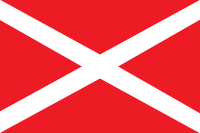Youth Democratic Anti-Fascist Movement "Nashi" Молодёжное демократическое антифашистское движение "Наши" | |
|---|---|
 | |
| Chairman | Vasily Yakemenko |
| Founded | March 1, 2005 |
| Dissolved | December 9, 2019 |
| Preceded by | Walking Together |
| Headquarters | 24th A Building, Pervaya Yamskogo Polya Street, Moscow, Russia |
| Membership | 150,000 |
| Ideology | Anti-Americanism Anti-democracy[1][2] Authoritarianism Anti-fascism Anti-revolutionary[a] Illiberalism Putinism Russian "Sovereign democracy" |
| National affiliation | All-Russia People's Front |
| Main organ | Rosmolodezh |
| Colours | Red White |
| Slogan | "Who if not us?" (Russian: "Кто, если не мы?") |
| Party flag | |
 | |
| Website | |
| nashi.su | |
Nashi (Russian: Молодёжное демократическое aнтифашистское движение «Наши», romanized: Molodezhnoye demokraticheskoye antifashistskoye dvizhenye "Nashi", lit. 'Youth Democratic Anti-Fascist Movement "Ours!"') was a political youth movement in Russia,[3] which declared itself to be a democratic, anti-fascist, anti-"oligarchic-capitalist" movement.[4] Nashi was widely characterized as a pro-Putin outfit,[5][6] with the Bureau of Investigative Journalism describing it as "Putin's private army".[7] Western critics have detected a "deliberately cultivated resemblance to" the Soviet Komsomol[8] or to the Hitler Youth[9][10][11][12] and dubbed the group "Putinjugend" ("Putin Youth").[13][14][15][16]
Senior figures in the Russian Presidential administration encouraged the formation of the group, which Moisés Naím labelled a government organized non-governmental organization (GONGO).[17] By late 2007, it had grown in size to some 120,000 members aged between 17 and 25. On April 6, 2012, the Nashi leader announced that the current form of the movement would dissolve in the near future, possibly to be replaced by a different organisation. He stated that Nashi had been "compromised" during the 2012 Russian presidential election.[18] In 2013, the organization ceased its activities and on December 2, 2019, the legal entity was liquidated.[19]
- ^ Albrow M, Glasius M, Anheier H, Kaldor M (2007). Global Civil Society 2007/8 : Communicative Power and Democracy. Global Civil Society - Year Books (PDF). Sage Publications. ISBN 9781412948005. Retrieved April 23, 2023.
- ^ "Democracy's Dangerous Impostors - Carnegie Endowment for International Peace". Carnegie Endowment for International Peace. Retrieved April 22, 2023.
- ^ Franchetti, Mark (September 2, 2007). Written at Moscow. "Putin's youth brigade targets Britain". The Times. London: News International Group. The Sunday Times. Archived from the original on August 13, 2008.
- ^ Johnson, David, ed. (April 15, 2005). "Russia: new youth movement intends to eliminate 'regime of oligarchic capitalism'". cdi.org. Excerpts from the Johnson's Russia List e-mail newsletter. Washington, DC: Center for Defense Information. INTERFAX. Archived from the original on April 19, 2005.
- ^ "Hacked emails allege Russian youth group Nashi paying bloggers". the Guardian. February 7, 2012. Retrieved March 29, 2023.
- ^ Myers, Steven Lee (July 8, 2007). "Youth Groups Created by Kremlin Serve Putin's Cause". The New York Times. ISSN 0362-4331. Retrieved March 29, 2023.
- ^ "How Russia's youth movement became Putin's private army". The Bureau of Investigative Journalism (en-GB). Retrieved March 29, 2023.
- ^ Hutchings, Stephen C; Rulyova, Natalya (2009) [first published 2008 online]. "Commemorating the past/performing the present: television coverage of WWII victory celebrations and the (de)construction of Russian nationhood". In Beumers, Birgit; Hutchings, Stephen C; Rulyova, Natalya (eds.). The post-Soviet Russian media: power, change and conflicting messages. BASEES/Routledge series on Russian and East European Studies. London; New York: Routledge. p. 153. ISBN 9780415419017.
- ^ Whipple, Tom (December 9, 2006). "Disturbing echo of youth group that lauds Putin". The Times. London.
- ^ Young, Cathy (August 10, 2007). "Putin's young 'brownshirts'". Boston.com. Boston.
- ^ Johnson, Reuben F. (July 31, 2007) [2007-07-30]. "The Putin Jugend: the Kremlin's teenage shock troops". The Weekly Standard. Archived from the original on February 9, 2013.
- ^ Matthews, Owen; Nemtsova, Anna (May 27, 2007). "Putin's powerful youth guard". Newsweek International.
- ^ Marcovici, Michael (2014). You are the target !: Or do you believe your government is always watching the others?. Norderstedt Books on Demand. p. 193. ISBN 9783735793553. [self-published source]
- ^ Fürst, Juliane (2010). Stalin's last generation: Soviet post-war youth and the emergence of mature socialism. Oxford University Press. ISBN 9780199575060.
- ^ Harding, Luke (2011). Mafia state: how one reporter became an enemy of the brutal new Russia. London: Guardian Books. ISBN 9780852652473.
- ^ Saunders, Robert A.; Strukov, Vlad (2010). "Nashi". Historical dictionary of the Russian Federation. Historical dictionaries of Europe. Vol. 78. Scarecrow Press. pp. 401–402. ISBN 9780810874602.
- ^ Naim, Moises (October 13, 2009). "What is a GONGO? How government-sponsored groups masquerade as civil society". foreignpolicy.com. FP Group of Graham Holdings Company. Archived from the original on January 4, 2015.
The Myanmar Women's Affairs Federation is a GONGO. So is Nashi, a Russian youth group, and the Sudanese Human Rights Organization.
- ^ "Gazeta.ru: dvizheniye "Nashi" likvidiruyetsya" Газета.Ру: Движение "Наши" ликвидируется [Gazeta.ru: movement 'Nashi' liquidated]. grani.ru (in Russian). ООО "Флавус". April 6, 2012. Archived from the original on April 8, 2012. Retrieved April 22, 2013.
- ^ Unified State Register of Legal Entities: NASHI Movement
Cite error: There are <ref group=lower-alpha> tags or {{efn}} templates on this page, but the references will not show without a {{reflist|group=lower-alpha}} template or {{notelist}} template (see the help page).